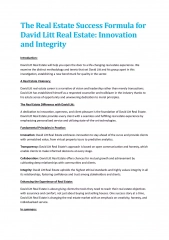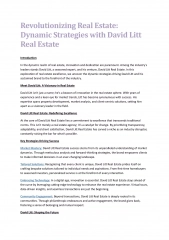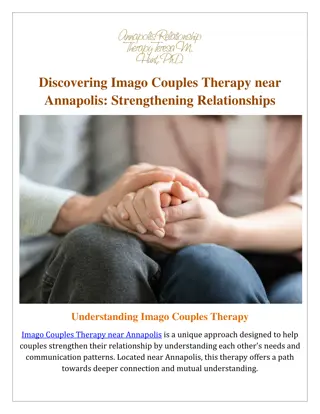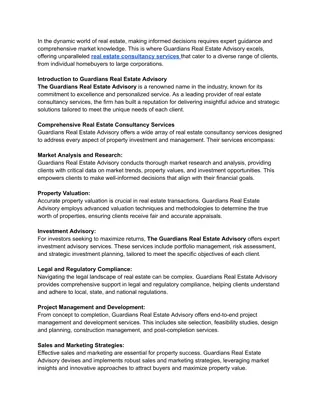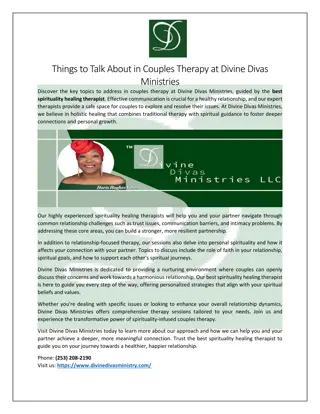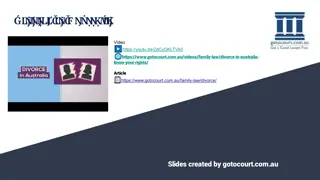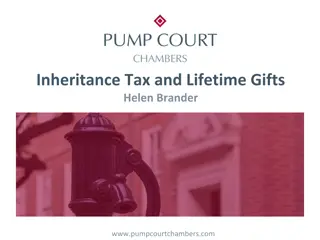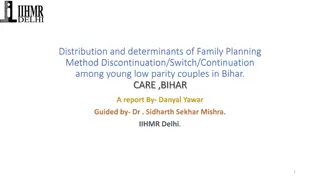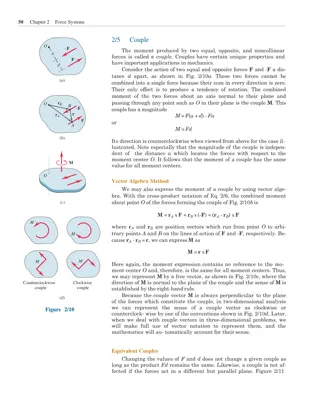Practical Estate Planning for Married Couples
Practical insights on estate planning for married couples, exploring the benefits of utilizing higher exemptions due to inflation adjustments, gift tax annual exclusions, and the use of Grantor Retained Annuity Trusts (GRATs) as a wealth transfer technique. Considerations for gifting strategies, LLCs for property management, and IRA charitable planning are discussed with real-life case studies.
Download Presentation

Please find below an Image/Link to download the presentation.
The content on the website is provided AS IS for your information and personal use only. It may not be sold, licensed, or shared on other websites without obtaining consent from the author.If you encounter any issues during the download, it is possible that the publisher has removed the file from their server.
You are allowed to download the files provided on this website for personal or commercial use, subject to the condition that they are used lawfully. All files are the property of their respective owners.
The content on the website is provided AS IS for your information and personal use only. It may not be sold, licensed, or shared on other websites without obtaining consent from the author.
E N D
Presentation Transcript
Practical Gift and Estate Planning Considerations Kripa Raguram November 7, 2024
1 2 Today s Topics Estate Planning for Married Couples Two Planning Concepts Use of LLCs to Hold Out- of- State Real and Tangible Personal Property 3 4 Case Study: Lifetime Gifting with Margin Loans Use of Swap or Substitution Power in Irrevocable Grantor Trusts 5 Splitting IRAs to Charity & QCDs
1 TOPIC 1 Estate Planning for Married Couples Two Planning Concepts
Estate Planning for Married Couples Two Planning Concepts Higher Inflation = Higher Exemptions TRANSFER TAX EXEMPTION INCREASE INFLATION ADJUSTMENTS 2024 2025 For married couples who think they have fully utilized their exemptions, higher exemptions due to inflation adjustments present a great opportunity to make new gifts to family members free of transfer taxes. PER INDIVIDUAL $690,000 $380,000 MARRIED COUPLE $1,380,000 $760,000 Use of gift tax annual exclusions of $18,000 to any individual in 2024 and $19,000 in 2025.
Estate Planning for Married Couples Two Planning Concepts GRATs are still an option Step 1 Grantor transfers asset(s) to an irrevocable trust While it is true that a GRAT is more appealing in a low-interest rate environment, it can still be an effective wealth transfer technique in a higher interest rate environment. Step 2 Grantor receives an annuity stream for a set term in cash or in kind A longer term GRAT may make more sense. A GRAT s success or failure depends on whether the appreciation of assets transferred to the GRAT can beat the Sec. 7520 rate (November November 2024 = 4.4%). Step 3 At end of trust term, remaining trust assets pass to beneficiaries free of gift tax. If grantor dies during trust term, GRAT fails, and trust assets are included in grantor s estate. The GRAT can be structured as a Zero d out GRAT, which means that the transfer of assets to the GRAT does not use any of the couple s transfer tax exemption or result in any gift tax owed.
Estate Planning for Married Couples Two Planning Concepts GRATs If the married couple own assets with significant growth potential, e.g., securities that are currently depressed but are expected to appreciate in the future sufficient to clear the Sec 7520 hurdle rate, they should consider implementing the GRAT strategy. Even if the GRAT fails (either due to a mortality risk or appreciation below Sec 7520 rate), there are no adverse tax or economic consequences other than the costs associated with the setup and administration of the GRAT. With uncertainty in the future of GRATs, from legislative proposals attempting to curtail the effectiveness of GRATs to uncertainty in future interest rates, taxpayers who have been contemplating Zero d out GRATs should consider acting sooner than later.
2 TOPIC 2 Use of LLCs to Hold Out-of- State Real and Tangible Personal Property
Use of LLCs to Hold Out-of- State Real and Tangible Personal Property Planning Opportunity: LLCs to Hold Out-of-State Real Property OREGON NONRESIDENT (CA RESIDENT) OREGON RESIDENT Worldwide Gross Estate of $1,000,000 or more and includes OR Real or Tangible Personal Property Worldwide Gross Estate of $1,000,000 or more FILING REQUIREMENT Worldwide Taxable Estate exceeds $1,000,000 and includes OR Real or Tangible Personal Prop. Estate planning should review location of assets to consider planning opportunities to mitigate estate tax liabilities to Oregon and other states. Worldwide Taxable Estate exceeds $1,000,000 TAX TRIGGERED IF Oregon Residents and Nonresidents are subject to Oregon Estate Tax but differently. OR Real Estate + OR Tangible Personal Prop + All Intangible Prop All Intangible Prop __________________ __________________ OR Real Estate + OR Tangible Personal Prop. __________________ __________________ FRACTIONAL FORMULA FOR OREGON ESTATE TAX Oregon estate tax statutes apply a fractional formula (ORS 118.010) that can result in unexpected results for an OR nonresident. Worldwide Assets Worldwide Assets Hold OR real property in an LLC - intangible assets not included in numerator and will avoid OR estate tax Hold Out of OR real property outright and apportion out to reduce OR Estate Tax A CA resident will be subject to OR estate tax even if all OR located property was to pass to charity or to a surviving spouse. PLANNING OPPORTUNITY
Use of LLCs to Hold Out-of- State Real and Tangible Personal Property Example: CA Resident CA resident dies in 2024 with $4 million gross estate consisting of $2 million of real property located in CA and $2 million in OR. She leaves CA real property to her children and OR real property to her spouse (eligible for the marital deduction). 2024 Form OR-706 Since the fractional formula computes tax on the worldwide taxable estate in excess of $1 million first, and then applies OR apportionment, OR estate tax of $50,625 will be owed.
Use of LLCs to Hold Out-of- State Real and Tangible Personal Property Planning Opportunity Place OR real property in an LLC (single member or multi-member), as Oregon treats a limited liability interest as an intangible asset (OAR 150-118-0010), like stocks, bonds, bank deposits, partnership interests. Intangible assets are not included in the numerator of the fractional formula and will avoid OR estate tax for a CA resident.
3 TOPIC 3 Case Study: Lifetime Gifting with Margin Loans
Case Study: Lifetime Gifting with Margin Loans Case Study Use of margin loans to reduce Oregon taxable estate while preserving basis step-up in certain situations Facts Wealthy OR Resident (surviving spouse) not in good health; four children-beneficiaries (OR/Portland Residents) Children filing status: Married filing joint (MFJ) 2024 projected long-term capital gains tax bracket: 23.8% Assets: Consists mainly of Portfolios of Highly Appreciated Long-term Capital Gain Securities - $5,000,000 Goals Preserve Basis Step-Up for heirs, without having to sell securities and incur tax on capital gains Use lifetime gifting to reduce OR Taxable Estate to below OR estate tax exemption of $1,000,000 Planning Secure margin loan with securities as collateral for $4,000,000 FYI Interest on Margin Loan not factored in calculations; payment of interest will further reduce OR Taxable Estate. Engage in lifetime cash gifting to heirs from proceeds of Margin Loan $4,000,000 Lifetime gifting should reduce OR taxable estate to below $ 1,000,000
Case Study: Lifetime Gifting with Margin Loans BUILT-IN LONG-TERM CAP GAIN GROSS ASSETS COST BASIS MARGIN LOAN OREGON RESIDENT FACTS: Original Portfolio of Appreciated Securities Margin Loan Proceeds 5,000,000 4,000,000 (1,000,000) 4,000,000 (4,000,000) LIFETIME GIFTING USING MARGIN LOAN: Lifetime Cash Gifts to 4 children Gross Assets Prior to Death (4,000,000) 5,000,000 OREGON ESTATE TAX SAVINGS: OR Gross Estate at Death Debts of Decedent (Margin Loan) Taxable Estate OR Estate Tax Exemption OR Taxable Estate - NONE 5,000,000 (4,000,000) 1,000,000 (1,000,000) - FEDERAL AND OREGON TAX SAVINGS TO HEIRS DUE TO BASIS STEP-UP: Federal Tax savings @ 24% on $4,000,000 gifted OR Tax savings @14% on $4,000,000 gifted Approx. Federal & OR Income Tax Savings 960,000 560,000 1,520,000
4 TOPIC 4 Use of Swap or Substitution Power in Irrevocable Grantor Trusts
Use of Swap or Substitution Power in Irrevocable Grantor Trusts E.g., Spousal Lifetime Access Trusts (SLATs) Spousal lifetime access trust (SLAT) - Taxable gift is made by settlor-spouse to an irrevocable trust for the benefit of the settlor s spouse and/or other family members (children/grandchildren). SLAT is an effective estate planning tool for married couples to utilize remaining higher exemption amounts, for one or both spouses, while still providing cash flow to the marital household. Inclusion of swap power or power to substitute (IRC 675), can qualify the SLAT as a grantor trust for income tax purposes while still removing assets from grantor s taxable estate It is the power to reacquire trust corpus by substituting other property of equivalent value. The power is exercisable by the settlor-spouse in a nonfiduciary capacity, without the approval or consent of any person acting in a fiduciary capacity (trustee). Substitution or swap provision is a powerful tool that adds flexibility to an irrevocable trust for grantor s investment, income tax and estate planning: E.g., swap equivalent cash for highly appreciated Apple stock held in the SLAT to preserve basis step-up through inclusion of the stock in the grantor s estate. E.g., swap equivalent cash for family business interest transferred to SLAT to gift business interest to daughter who is now more active in the business than the son.
Use of Swap or Substitution Power in Irrevocable Grantor Trusts Spousal Lifetime Access Trusts (SLATs) IRS Revenue Ruling 2008-22 provides important guidance: The use of substitution power should not result in the SLAT assets being included in the grantor s gross estate. The trustee is under fiduciary obligation to ensure assets swapped/substituted are of equivalent value. Right to swap is not a taxable gift but consider reporting the swap on a gift tax return at zero value. If adequately disclosed, it will serve to toll the statute of limitations for a later IRS audit. In conclusion: This useful tool is often forgotten after the trust instrument is signed and safely put away. Basis step-up at grantor s death from assets swapped can be a valuable income tax opportunity to heirs by eliminating capital gains tax. It is time to review the trust instrument to look for the power and the options for its application.
5 TOPIC 5 Splitting IRAs to Charity & QCDs
Splitting IRAs to Charity & QCDs IRAs and Charities IRAs are often great assets to use for charitable gift purposes to avoid ordinary income and not loose out on charitable (itemized deduction) mechanics. QCD limit for 2024 = $105,000 For Estate planning purposes avoid the complications of directing large IRA accounts by splitting an existing IRA into two separate (or more) accounts: Account #1 names the charity as the beneficiary. This account will also fund the annual QCDs while the owner is alive. At time of passing, remainder of IRA passes to charity. No net Estate tax satisfies charitable intent. Account #2 name the individual beneficiaries asset would be pass to individuals at time of passing. Would be taxable to decedent s Estate. Avoid group from being subject to the lowest payout timeline (5 years versus 10 years).
Your Presenter CPA, DIRECTOR Kripa Raguram Perkins & Co EMAIL PHONE kraguram@perkinsaccounting.com 503.221.7588
EMAIL Thank you! hello@perkinsaccounting.com PHONE 503 221 0336 ADDRESS 1211 SW 5th Ave, Suite 1000 Portland, OR 97204 Our purpose of presenting this seminar is to educate you regarding planning strategies. It is not intended as a substitute for specific professional advice. Professional tax advice may only be given in response to inquiries regarding particular situations.


